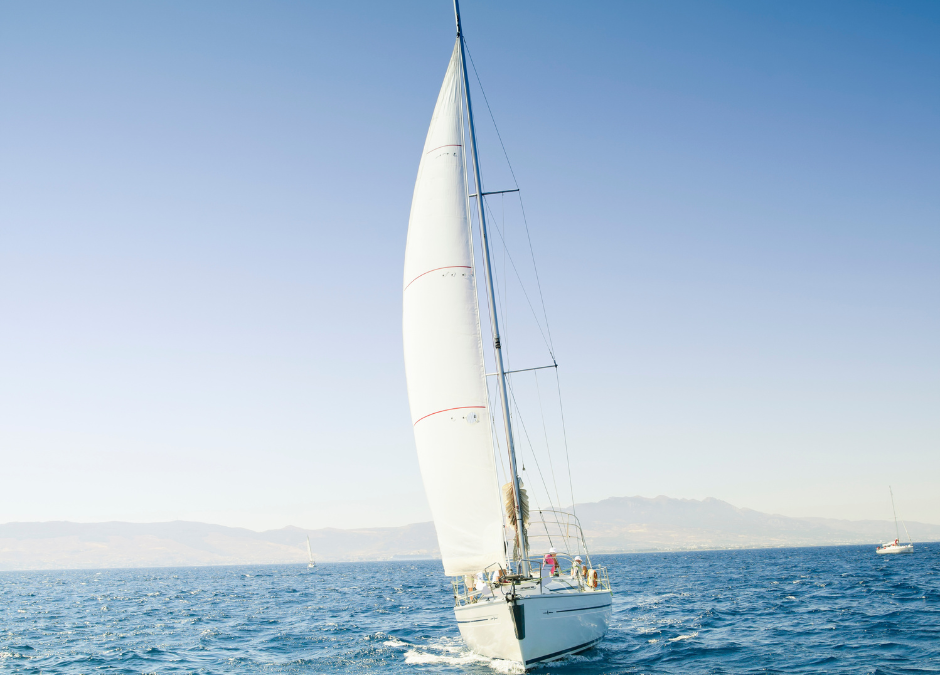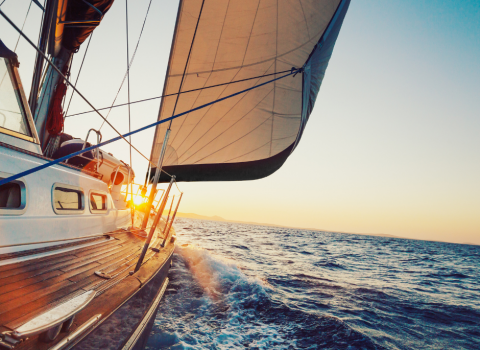- Per info e Contatti
- +39 0547.631068
- info@lamconsulting.it
Sailing through Complexity

Team building aziendale: veleggiare nella complessità
15 Giugno 2022
Le segretissime tecniche di vendita
20 Settembre 2022What can organizations learn from sailing?
The sailing experience has been used in outdoor business training to provide a pleasurable team-building experience and to reflect on leadership and teamwork. Since I’ve decided to live on a sailboat for 5 months a year, I started to explore the sailing experience as a powerful metaphor for a very impactful aspect of the organizational realm: being and changing in an everchanging, unpredictable, complex environment
Here are the 5 insights that I’d like to share:
- If we look at a route in the wind map, we suddenly realize that in each specific position, our sails will be hit from a slightly different angle. The wind doesn’t come all from the same direction and it’s not stable. Even if we stand still at the same spot in a location, the wind is not stable, and neither its direction nor its intensity is stable. This unpredictability means that we cannot plan everything in advance: on the contrary, we should trim the sails step by step, mile after mile. The planning doesn’t vanish, but it shifts below a much more useful ability which consists in being able to adapt oneself to the changing environment. If classical managerial models were based on prediction and control, as we look at the organizations as complex entities that sail across a complex unpredictable ocean, a new set of competencies, like those of an experienced sailor, become necessary.
- Having talked about the ‘local’ management, now I’d like to broaden the perspective to the entire route. Let’s say we planned to go to Venice, starting from a Southern Italian port. On the day of our departure, the wind blows strongly from north-northwest: right into our bow: our boat cannot sail to Venice, at least not by the shortest route. What can we do? We can plan to postpone the departure waiting for better conditions or we can choose to follow another route, maybe to Croatia: we utterly change our plan. I know that this approach might sound disorienting throwing away all at once years of goal-centered theories of development. But we might argue that the faster decline and death of many companies are just the result of an ideal stubbornness toward one stiff goal. Is it not better for a company to keep on with its sailing, even changing direction when necessary, than holding itself stuck upwind?
- The sailboat also teaches something valuable about the team functioning. It’s even too obvious to say that the trimming is conditioned by the internal variable as well as the external ones: the ability, experience, reactivity, physical state of the crew members; their state of mind, the will to collaborate, and the reasons why they’re on the boat are all elements that will interfere and influence our decisions, of course. But another little revolution can happen here setting upside down the idea of a commander who orders and a crew that obeys in a coordinated effective manner. I’d like to depict this idea through a real experience: a boat is about to enter the port of a small Italian town in Tuscany. Just outside the bay, the main sail is furled and the engine is ignited, then the crew furls the front sail. The wind is strong and constant waves hit the sturdy hull. At that moment, the captain sees black smoke coming out from the engine compartment. Everybody comes out like a bee; down there it’s not possible to breathe anymore. For the twenty-year-experienced captain, it was the first time, and he was frightened to the bones. More agitated than the sea, he made a phone call to the charter’s owner: shouting for despair and for overcoming the clash of the waves, he explained the problem. The owner suggested that the captain should stay calm, open the compartment and check on what was happening. The captain, holding the helm tight, shouted at anyone to do the job. At that point, the youngest and less experienced member of the crew said: “Don’t do that, for the hell’s sake!”. The captain inquired him with an eternal gaze. But the young boy had just gotten the license some months before and he remembered clearly one of the questions in the examination: if the engine is on fire, never, never, never open the compartment unless you want the fire to take over everywhere, fed by the oxygen. They used an extinguisher through a proper hole until the smoke faded away. In that situation, a spontaneous widespread leadership, as we might call it, saved their lives. Each member of the team, no matter how little experience they have, can share their gift if the hierarchy gives its way to a circular, open relationship. In how many organizations can you really breathe that everybody feels free to express him/herself without any fear of consequences?
- Sailing provides deep wellbeing. I saw first-hand this benefit one winter afternoon when I went out to do some regulation to my boat. My mood was really low for a problem that I could fix with a client, a very impolite client! I had been dwelling on that issue since the day before and I couldn’t figure out a way out. My stomach was in a knot. After just one mile out in the sea, I started noticing that my whole body was relaxing. Lulled by the smooth current, hearing the lapping on the side of the boat, the fresh wind stroking my chin. My mind cooled down, the thoughts slipped away, and I stopped thinking about that problem. After about one hour, while maneuvering a tack, a solution popped up in my consciousness. Porges, the father of the Polyvagal Theory, lists a series of somatic experiences that are able to calm our nervous system down. He refers to this as the ventral vagal pathway, which enables us to be more flexible, more creative, more in touch with our deep feelings, and more open to the relationship with others. His studies revealed that contact with nature, contact with blue-green spaces, and listening to the sound of a river are powerful ways of conditioning our autonomous nervous system. The lateral floating of our defocused eyes on the line of the horizon can be healing. I think that this wellbeing I’m referring to is a key asset for an organization that deals with complexity: how can a linear logic narrowed into a tunnel vision typical of the fight or flight modality help otherwise? How can we get in touch with other people in a productive and collaborative way when our alarm system is activated? It emerges that wellbeing is not just a ‘good’ per se, it’s also the foundation for the open and flexible mindset that we expressed in the previous considerations. Sailing gives you a quick experience of this. That’s why I decided to move my company’s headquarters on a sailboat. We make decisions while sailing. Yes, we are a small company and I know that it’s not possible for the majority of organizations to do the same. However, once you had the experience, it’s hard to go back to the old habit. Many things can be done in a common office: how many meetings start with a synchronized breathing practice? How many times did you relax your psoas before an important event?
- Getting oneself lost in the unknown to find a new way. Going down memory lane, when Magellano had the primary goal of finding a western route to the Moluccas the Spice Islands, he didn’t have maps and every large estuary; he thought about exploring th Amazon River to figure out if it was the passage to the other side. We might realize that the journey of our organizations is, in some ways, an adventurous trip rather than a contemporary trip with GPS and all our perfect knowledge. Who would have said, just three years ago, that our entire life was about to be tossed upside down into a dystopian movie with masked people, lockdowns, constriction to attend a mass vaccination, loss of the right to have a job, a wide crack in the society, scarcity and a bursting of the costs of commodities? And if our journey across the sea of complexity is indeed such a leap into the unknown, maybe the spirit, mindset, and nerve of those early pioneers should be the key to thriving. Everyone talks about innovation today but there’s always some resistance to letting go of the known territories to foray into the new. It’s so understandable: stepping in on a new island may mean finding the gold or being eaten by cannibals. But how can there be an innovation if we ask our people to tack along familiar routes?
These aspects don’t erase all that we know from traditional management theories. Being open to anybody’s suggestion and having a distributed leadership doesn’t really mean we have to avoid any hierarchy: we can have both with a proper dosage of flexibility. Similarly, having an adventurous mindset and curiosity for unexplored territories doesn’t mean going in blind, without warm clothes just in case we push ourselves up North.
Actually, sailing by adapting to the internal and external conditions doesn’t mean having no outcomes as changing the route along the way doesn’t mean avoiding any plan. In my perspective, this approach to complexity adds choices rather than diminishing them.
What sailing teaches organizations is that if they want to thrive through complexity, they need to develop more flexibility: having goals, yet constantly reading the environment; keeping the helm on the route, yet never getting stuck into it. Curiosity rarely kills the cat: usually, it gives a more playful life; openness helps so much; we might just remember that courage is not the absence of fear but flowing through the change we consider empowering, despite the fear.
An organization, like an individual, can face that critical point where everything around is telling that a change is needed. Sailing is a powerful metaphor to get insights into all that. In this regard, I remember the personal journey of Moitessier, the father of solitary travelers around the globe. He had reluctantly accepted to be part of a solo race around the world; well, winning the race meant earning a great sum of money, and he needed it. It seemed foolish not to join it. However, in his heart, he knew that wasn’t his story, and almost at the end, targeting Cape Town, instead of launching the bow of his vessel toward the finishing line, he tossed a message for the regatta organizers onto an oil tanker passing by: “I continue non-stop to the Pacific Islands because I am happy at sea, and perhaps also to save my soul!”
Andrea Magnani
CEO & Founder LAM Consulting srl Sb





